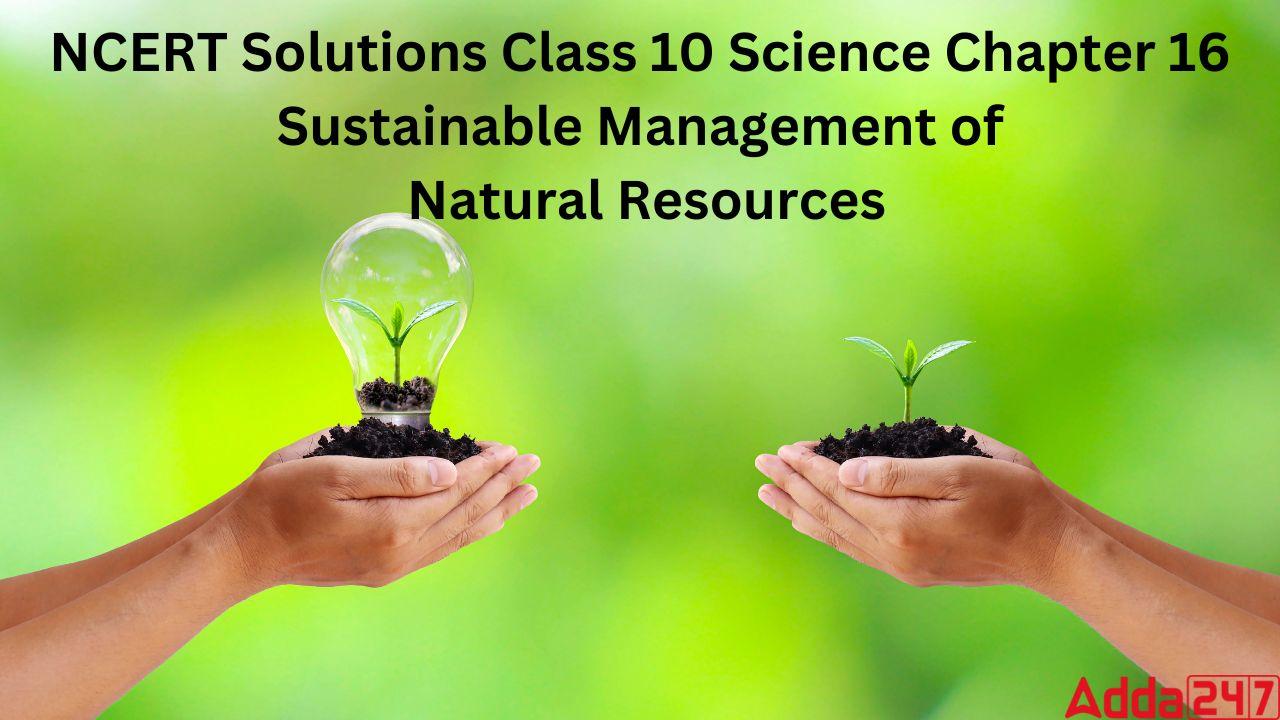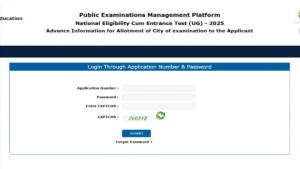Table of Contents
NCERT Solutions for Class 10 Science Chapter 16: Sustainable Management of Natural Resources
NCERT Solutions Class 10 Science Chapter 16 Sustainable Management of Natural Resources is given in the article.NCERT Solutions Class 10 is the best resource for obtaining a good score in the class 10 board Examination. Your preparation for the CBSE examinations will be aided by the NCERT Solutions for Class 10 Science Chapter 16 Sustainable Management of Natural Resources. Here are Adda247 Expert faculty team prepared NCERT Solutions Class 10 Science Chapter 16 Sustainable Management of Natural Resources along with in-text questions and exercises of that chapter for a better grasp of the topics. These solutions will help you understand the concepts covered in the chapter completely. So that students can pass their board exams with good scores. Keep learning with Adda247.
Read: NCERT Solutions Class 10 Science Chapter 15 Our Environment
NCERT Solutions for Class 10 Science Chapter 16 Sustainable Management of Natural Resources Question & Answer pdf
NCERT Solutions for Class 10 Science Chapter 16 Sustainable Management of Natural Resources can help you learn about natural resources, their availability, and their best management. Click here to download NCERT Solutions Class 10 Science Chapter 16_ Sustainable Management of Natural Resources
NCERT Solutions Class 10 Science Chapter 16: Quick Revision
Let’s take a quick look at the topics and subtopics covered in chapter 16 Sustainable Management of Natural Resources before solving the Intext questions and exercises.
- Sustainable Natural Resource Management
- Why Is Resource Management Necessary?
- Animals And Forests
- We All Need Water
- Petrol and Coal
- Natural Resource Management Overview
NCERT Solutions for Class 10 Science Chapter 16: Video Explanation
Watch the below-given video explanation of Sustainable Management of Natural Resources
NCERT Solutions Class 10 Science Chapter 16- Sustainable Management of Natural Resources Notes
In-text Questions Page: 271
1. What changes can you make in your habits to become more environmentally friendly?
Answer: The practices listed below can be integrated into our daily lives to help the environment:
- Minimize the utilization of Electricity, When not in use, turn off the lights, fans, television, and other electrical devices.
- Sort trash into recyclable and non-recyclable components
- Use renewable energies instead of fossil fuels.
- Use the local transport system, instead of personal vehicles.
- it’s important to limit how much water you take. Try to use washing machine waste water for cleaning.
- Reuse and Recycle bottles, paper, and plastic. Glass and plastic garbage should be disposed of in recycling containers.
2. What would be the advantages of exploiting resources with short-term aims?
Answer: The exploitation of resources with regard to short-term goals relates to the utilization of resources to meet the immediate and current basic demands, and is particularly advantageous for the current generation. It will contribute to faster economic growth, but it will also have a negative impact on nature and the environment. The resources that might be accessible to future generations may not always be taken into account in this.
3. How would these advantages differ from the advantages of using a long-term perspective in managing our resources?
If we manage our natural resources with a long-term view, they will last for many generations to come. The conservation of resources so that they may be used by future generations is made possible by the long-term model of resource utilization. The economy will be able to grow as a result over a more extended period of time. Overall, compared to a short-term perspective, the long-term view in resource management offers a substantial number of advantages.
4. Why do you think that there should be equitable distribution of resources? What forces would be working against an equitable distribution of our resources?
The Earth’s natural resources must be distributed equally among all people in order for each to receive their fair share.
The forces working against a fair distribution of resources are:
- The distribution of resources by regions like petroleum, coal, minerals, natural gases, and many more aspects.
- Human greediness, inequality, corruption
- unequal utilization of resources between the rich and the poor.
In-text Questions Page: 275
1. Why should we conserve forests and wildlife?
Forests and wildlife should be protected because:
- There are several plant and animal species that can be found in forests. Because they preserve natural harmony, forests are in part to blame for the predictable seasonal cycle. is a significant source of oxygen
- The loss of numerous significant species and disruption of the food chain can result from the destruction of these forests, leading to an unstable ecosystem.
- Forests are essential to the preservation of tribal populations’ culture and traditions. Many people depend on forests for their livelihood.
- For the stability of the environment, it is crucial to preserve forests. In addition to preventing soil erosion, trees are essential to the water cycle.
2. Suggest some approaches toward the conservation of forests.
The following approaches can be taken to preserve forests:
- Impose strict laws to combat deforestation.
- Plant more trees to halt deforestation
- Security personnel is stationed in the woods to stop poaching and the illegal trade in forest products.
- Sensible and judicious use of forest resources.
- Preventing the development of roads, structures, and dams on forest land.
- The right precautions should be taken to keep illnesses and pests out of the forests.
In-text Questions Page: 278
1. Find out about the traditional systems of water harvesting/management in your region.
Many of us reside in urban areas where municipal agencies provide water. Groundwater and lakes are the main sources of water for homes in populous metropolitan areas. While pipes take water directly from lakes, borewells are used to extract groundwater. After being collected, the water is stored in water tankers positioned across the city.
2. Compare the above system with the probable systems in hilly/mountainous areas or plains or plateau regions.
In hilly areas, Rainwater is collected and channeled with the aid of a stream in hilly areas. For irrigation purposes, the stream is redirected through canals to various locations. In hilly areas, this system of canal irrigation known as Kulhs
In the plains, Earthen embankments in the shape of crescents are used as water harvesting structures in plains, These are low, straight, and made of concrete. In the plains, water is received from numerous natural sources like lakes and rivers. Borewells are used to extract groundwater for irrigation and human consumption.
3. Find out the source of water in your region/locality. Is water from this source available to all people living in that area?
In my locality, municipal agencies provide water which mainly obtains from rivers. Groundwater and lakes are the main sources of water for homes in populous metropolitan areas.
Most people can enjoy the water source in our area, but some people from key areas depend on groundwater and water tankers are used to transport water across the city.
NCERT Solutions Class 10 Science Chapter 16 Sustainable Management of Natural Resources
1. What changes would you suggest in your home in order to be environment-friendly?
Several significant changes that can make homes more environmentally friendly include:
- Separation of wastes into non-biodegradable waste and biodegradable waste.
- Immediately fixing plumbing issues and adopting water-saving techniques can help you avoid wasting water.
- Using environmentally friendly products like paper cups and cloth shopping bags in place of plastic ones.
- Minimize the utilization of Electricity, When not in use, turn off the lights, fans, television, and other electrical devices. you may prevent energy waste.
2. Can you suggest some changes in your school which would make it environment friendly?
In order to make our schools more environmentally friendly, the adjustments listed below should be implemented:
- Separate bins should be used for biodegradable and non-biodegradable waste.
- We can save electricity by turning off lights and fans when no one is in class.
- When not in use, turn off the water taps to prevent water wastage.
- Use of local transportation instead of personal vehicles.
3. We saw in this chapter that there are four main stakeholders when it comes to
forests and wildlife. Which among these should have the authority to decide the
management of forest produce? Why do you think so?
The government’s forest department ought to have the authority to make decisions regarding the management of forest products. This is so that the forest department, which also bears responsibility for any harm to the forest, may be held accountable for taking care of the forest area. The government’s resources can be used by the forest authority to effectively maintain and preserve the forest regions.
4. How can you as an individual contribute or make a difference to the management
of (a) forests and wildlife, (b) water resources, and (c) coal and petroleum?
The following are some ways that I personally can influence or contribute to the management of forests and wildlife, water resources, coal, and petroleum:
(a) forests and wildlife
- Impose strict laws to combat deforestation.
- We should raise our voices in opposition to tree cutting.
- Security personnel is stationed in the woods to stop poaching and the illegal trade in forest products.
- Sensible and judicious use of forest resources.
- Preventing the development of roads, structures, and dams on forest land.
- We should raise awareness about wildlife poaching.
(b) water resources:
- Rainwater collection should be done regularly.
- It should be illegal to dump sewage and other trash into rivers and other water sources.
- It’s crucial to keep your water intake in check. Consider cleaning using washing machine waste water.
- When not in use, turn off the water taps to prevent water wastage.
(c) coal and petroleum :
- Use of local transportation instead of personal vehicles.
- We can save electricity by turning off lights and fans when no one is in class.
- replacing standard bulbs with energy-efficient lightings such as CFLs and LEDs.
- Use renewable energies instead of fossil fuels.
5. What can you as an individual do to reduce your consumption of the various natural resources?
Natural resources including water, forests, coal, and petroleum, among others, are crucial for people. The methods we can use to limit the use of different natural resources are:
- We ought to cease felling trees.
- We should plant more trees.
- To minimize the removal of trees, we should utilize recycled paper.
- We should use renewable energy sources like hydropower and solar power.
- We should avoid the wastage of Electricity.
- We should use the local transport system instead of personal cars.to reduce our usage of petroleum,
- We should employ rainwater collection techniques.
- We must avoid wasting water.
6. List five things you have done over the last week to —
(a) conserve our natural resources.
(b) increase the pressure on our natural resources.
Natural resource conservation techniques include:
- Use renewable energies instead of fossil fuels.
- Using public transportation and bicycles to travel will help you use less gasoline.
- Utilization of recycled paper and other recycled goods.
- Separate trash containers for biodegradable and non-biodegradable wastes
- Conserving water by using it wisely and repairing any leaking faucets or pipelines.
- Switch off the fans, lights, and other electric appliances when not in use.
- Use of biodegradable bags such as jute bags instead of plastics.
Natural resource-depleting practices include:
- Leaving electrical appliances turning on after use is a waste of energy.
- Waste water by leaving the tap running and Disregarding any leaking pipes or faucets.
- Excessive use of fossil-fueled vehicles.
- Excessive use of plastic goods like plastic bags
7. On the basis of the issues raised in this chapter, what changes would you incorporate in your lifestyle in a move towards the sustainable use of our resources?
To use our resources sustainably, one should adopt the modifications to their lifestyle that are listed below:
- Stop felling trees and start practicing tree planting.
- Switch to renewable energy sources from fossil fuels.
- You can use less gasoline by traveling on a bicycle or by taking public transportation.
- Use of environmentally friendly products, such as paper cups and cloth shopping bags in place of throwaway plastic cups and non-biodegradable polythene bags
- Using recycled paper and other recyclable products.
- Replacing standard bulbs with energy-efficient lighting such as CFLs and LEDs.
- Separate bins should be used for biodegradable and non-biodegradable waste.
- The least amount of water should be used, and leaky faucets should be promptly fixed.
- Use water wisely and prevent water waste by promptly fixing any leaking taps or pipelines.
Sustainable Management of Natural Resources-FAQs
Q.How can natural resources be sustainably managed?
We can ensure that we have access to beneficial materials in the future by practicing the conservation of natural resources. Follow the three R’s: reduce, reuse, and recycle to conserve. Reduce simply means to use less. Reusing something implies putting it to use once again, giving it to someone who will use it, or altering it so that it can be put to use in another way.
Q.Why do we need to have sustainable management of resources?
This includes the way we care for, develop, and utilize our natural resources. A badly managed environment worsens these issues by raising long-term hazards to our well-being. People and our economy can both be sustained by a healthy and resilient environment.
- Stop felling trees and start practicing tree planting.
- Switch to renewable energy sources from fossil fuels.
- You can use less gasoline by traveling on a bicycle or by taking public transportation.
- Use of environmentally friendly products.
- Avoid water wastage.
- Turning off Lights and fans and other electric appliances when not in use.
Q. What are the aims of sustainable management?
The Sustainable Development Goals, commonly referred to as the Global Goals, aim to balance social advancement, environmental sustainability, and economic growth, guaranteeing that everyone has access to the same opportunities and can live better lives without endangering the environment.
Q.Which activity protects our natural resources?
The practice of conserving natural resources means preserving them for present and future generations.



 NEET City Intimation Slip 2025 Out at ne...
NEET City Intimation Slip 2025 Out at ne...
 CUET Chapter Wise Weightage 2025 for Sci...
CUET Chapter Wise Weightage 2025 for Sci...
 [Live Update] UP Board Result 2025 Class...
[Live Update] UP Board Result 2025 Class...










